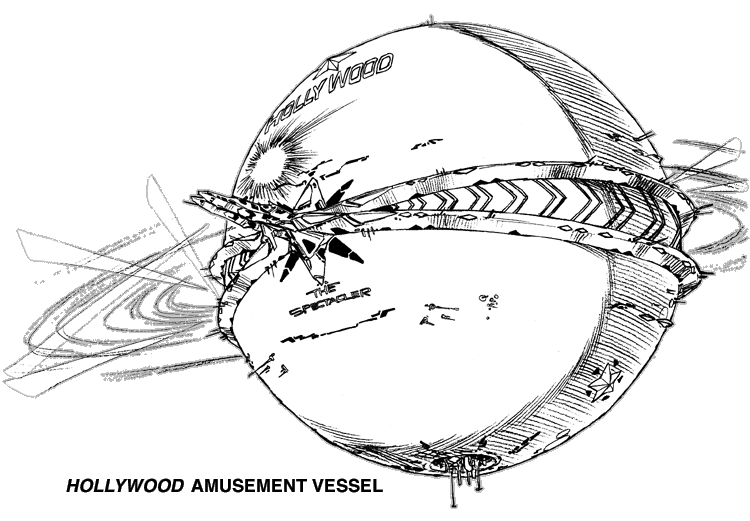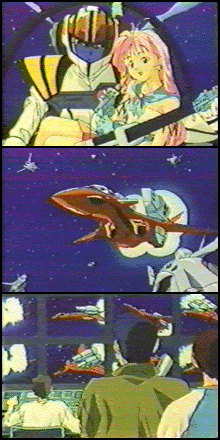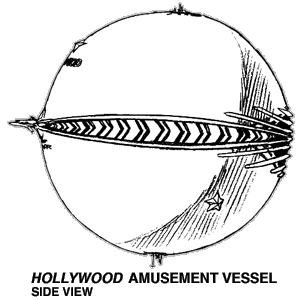
UGC Clariant Flag. | Hollywood-Class Amusement Ship. | 
UGC Clariant Flag. |
|---|
Despite the adventure and romanticism of sci-fi media, space can be a very boring place. This is especially dangerous for colony missions, where millions of soldiers and civilians are crammed into starships facing an unknown and uncertain future. In addition to food, water, and air, the shipboard colonists need a wide variety of entertainment to keep their morale up and keep them distracted from the possible danger they may be in. This is the justification for the Hollywood-Class Amusement Vessels.Hollywood-Class vessels are immense starships. Based on an older colony vessel design, they do not have a transparent dome like the Riviera- and New Macross-Class colony vessels. Instead, the spherical vessels are divided into three sections. The first section located in the top part of the ship contains a complete amusement park for the benefit and entertainment of the colonists.  | | UGS Hollywood Herself, Namesake Of The Class. |
|---|
 | A Documentry On The First Robotech War
Shot Entirely On UGS Hollywood. |
|---|
This park contains the latest in rides, games, shows, and other diversions one would typically find in a theme park on Earth. In addition, the park contains holographic virtual reality centers where people can star in their own movies, playing the part of a formula 1 racer or a variable fighter pilot without being in danger. Also there are cinemas, nightclubs, bars, restaurants, and other facilities for visitors who prefer a slightly slower pace to their entertainment.The middle part of the colony sphere contains the engines and power systems for the vessel, plus the living quarters for the 200,000+ colonists permanently living on the ship. The third section of the ship represents the most important function of the Hollywood, however. The entire lower half of the sphere is dominated by sound stages, recording studios, costume and prop shops, special effects computer editors, and all other equipment necessary for producing audio and video (both 2D and 3D) entertainment. Functioning like its namesake, this part of the Hollywood-Class constantly produces new films, records and features for the colony. In addition, the Hollywood-Class vessels also use their hyperspace communicators to keep in touch with other colony missions around the galaxy, allowing them to exchange their productions, sharing ideas and entertainment. This communications link between colony missions is called the Galaxy Network, and has become the initial starting point for stars and idol singers around the galaxy for almost 20 years.Like most other colony vessels, the Hollywood ships are unarmed and have only modest defensive systems. Instead, they rely upon an ARK ROYAL-Class Escort Battle Carrier that is docked to the front of the ship for protection, similar to how the NEW MACROSS-Class Battle and City sections combine for mutual protection. Hollywood-Class vessels are controlled from the bridge of the docked carrier, and the carrier's VF squadrons provide protection for the colony vessel in case of attack. The carrier can disconnect from the Hollywood-Class if necessary, and the vessel is equipped with an emergency bridge to control the ship when the carrier is detached. Hollywood-Class vessels are considered an essential part of UGC colonial missions and at least one of these vessels has accompanied every colony fleet since 2026. Although the design is somewhat dated, the vessels are still being constructed and will still be in use for many years to come.The Hollywood-Class is unusual in that the Pinpoint Barrier is THE critical weapons system; Without it, the ship is essentially defenseless in it's entirety. However, from lessons learned over the centuries the Hollywood-Class IS now equipped with some lighter weapons systems, most notably the Defensive Laser Batteries (100) and Automated Missile Battery (10).Note: The theme park interior of the Hollywood vessels contains miniature replicas of famous monuments from Earth, including the Statue of Liberty, the Eiffel Tower, Big Ben and others. In this respect, the vessels are very similar to "Culture Park" from Macross. (The Culture Park maps from Macross II Deck Plans Volume III can be used to represent the interior of Hollywood-Class vessels for encounters within these massive ships.)
Government: United Galaxies Council
Ship Type: Long Distance Colonization Amusement Vessel
Class: Hollywood-Class
Manufacturer: ORTEC Company/Three Star Heavy Industries/UN Spacy
Crew (not including Escort Carrier): 212,500 total (plus tourists)
Military Crew: 1,500
Civilian Crew: 8,000
Police/Civil Defense: 3,000
Permanent Civilian Populace: 200,000
Visitors/Tourists: up to 100,000 max
MDC By Location: |
Hull
Connection Joint/Engineering Section
** Main Engines/Power Plant (2)
** Auxiliary Engines (4)
Upper Sensor/Transmitter Cluster
Lower Sensor/Transmitter Cluster | 240,000
9,000
80,000 each
8,000 each
1,200
1,200 | Small Airlocks/Access Hatches (400)
Main Airlocks (2)
Outer Hull (per 40ft area)
Interior walls (per 20ft)
*** Pin Point Barriers (4)
| 250 each
800
120
15
5,000 each
|
| Notes:* Depleting the MDC of the main body will essentially destroy the vessel. All internal systems will shut down, including life support and internal gravity. The colony ship itself will be an unsalvageable floating wreck, and any surviving colonists must be rescued quickly or will die from asphyxiation as the remaining atmosphere drains into space.** Depleting the MDC of the main engines will force the ship to rely on its auxiliary engines. Depleting the MDC of the main engines AND auxiliary engines will leave the colony ship adrift in space. If in an atmosphere, the colony will crash (destruction of the main engines will render the antigravity system useless due to loss of power).*** The Pinpoint Barriers regenerate at a rate of 1,250 MD per second (2,500 MD per melee round). If destroyed, a barrier will completely regenerate within four seconds (2 melee rounds). See the Pinpoint Barrier System entry for details.Speed and Statistical Data: |
Speed (sublight): 0.16 speed of light (25,600 miles per second).
Speed (Auxiliary Drives): Mach 3.
Space Fold: Range Unlimited (1 light year every 6 minutes).
Planet bound: Designed to land in a planetary ocean when necessary but not designed to maneuver in an atmosphere. Hollywood-Class vessels are NOT designed to land on the ground. If they do so the landing will inflict 3D6 by 1000 MD damage to the main body of the spacecraft (the lower sensor/transmitter will be automatically destroyed).
Maximum Range: Unlimited (estimated 30 year life span).
Length (main body): 16,335 ft (4,950 m).
Height (main body): 17,655 ft (5,350 m). | Length (connector/engineering section): 594 ft (180 m).
Length (overall, including Uraga): 21,880 ft (6,630 m).
Weight: Approximately 530,000,000 tons standard.
Power System: ORTEC/General Galaxy Main Reactor.
Fold System: ORTEC/Shinnakasu/General Galaxy Advanced Fold System Cluster.
Sublight Drive: ORTEC/Centinel Impulse Drive Cluster.
Gravity Control System: Internal.
Auxiliary Engines: Shinnakasu/Shinsei Industries/Agar Nuclear Pulse Rocket Motor Clusters.
|
| Weapons Systems:The Hollywood-Class is unusual in that the Pinpoint Barrier is THE critical weapons system; Without it, the ship is essentially defenseless in it's entirety. It should be noted that there was much objection to the arming of these vsls, especially among the civilian non-crew populace (hotel/wait staffs, theater crews and stars); However, when the UGC's Armed Forces Survey Board approved the recommendations given them by the joint Spacy-Patrol Investigation Review Panel, and then Chairman Aurora STERLING-HUNTER signed the executive order, the ships crews breathed a major sigh of relief. |
1. Pinpoint Barrier Defense System: Originally developed by researchers onboard the SDF-001 MACROSS during the Fɪʀsᴛ Rᴏʙᴏᴛᴇᴄʜ Wᴀʀ, the Pinpoint Barrier System is a standard defense system on board all UGC Flagged-starships and colony vessels, including the Hollywood-Class and the Hollywood-Class is unusual in that the Pinpoint Barrier is THE critical weapons system; Without it, the ship is essentially defenseless in it's entirety. The system generates four small disc-shaped force fields that can be positioned anywhere along the ship to deflect missiles, energy beams or projectiles. Each pinpoint barrier is about 200 ft (61 m) in length and can absorb up to 5,000 MD in damage, which then regenerates within four seconds (2 melee rounds). The barriers can also be layered on top of each other to generate a field which provides 20,000 MDC and can even deflect heavy particle beams (usually).The four barriers are controlled by operators in the command tower of the carrier. These operators are instructed to defend (1) any breaks or weaknesses in the main hull, (2) the engineering section/battle carrier docking section, and (3) the main and auxiliary engines, in that order. The operators primarily concentrate on defending the ship against larger spacecraft and leave defense against attacking Mecha to the VF pilots.
Purpose: Defense (the pinpoint barrier system cannot be used as a weapon).
Range: Up to 300 feet (91.5 m) from the surface of the vessel.
MDC: Can sustain up to 5,000 MD per round. Regenerates at a rate of 2,500 MD per melee round.
Radius: 200 ft (61 m).
Attacks Per Melee: Can move from one end of the vessel to the other in less than a single round. Trained operators can attempt to block attacks up to 8 times per melee (counts as a parry) and are at +7 to block. Untrained characters can parry up to their number of hand-to-hand attacks with their normal parry bonuses only.
Payload: Nearly inexhaustible. Will work as long as system is functional (see below) and engines are intact. If main engines are destroyed, the barrier will loose power and not function.
Note: If all four barriers are grouped in a single spot they can deflect a heavy particle beam attack, such as the one generated by the Macross Cannon and Tsentrædi command warships. However, the beam will completely destroy all four barriers and put incredible strain on the pinpoint barrier system, to the point where it may short out. After deflecting an energy beam, roll percentile dice on the table below to determine additional effects/damage.01-15: Lucked out, system will be operational in 1D6 hours.16-30: Minor damage, system will require 4D6 hours to repair.31-45: Major damage, system will require 2D6 by 10 hours to repair (yes, DAYS of work).46-60: Completely destroyed! System can be rebuilt, but will require new parts and 2D6 DAYS of work to replace.61-75: Major damage, system will require 2D6 by 10 hours to repair.76-90: Minor damage, system will require 4D6 hours to repair.91-95: Lucked out, system will be operational in 1D6 hours.96-00: It's a miracle! Trivial damage only, system will be operational again in only 4D6 melee rounds! | 2. Defensive Laser Batteries (100): Each vessel has at least 100 defensive laser batteries for anti-missile and meteorite defense.
MD: 5D6 per blast.
Rate of Fire: Per gunners attacks per melee plus bonuses (generally 4 or 5 per melee).
Range: 500 feet.
Payload: Unlimited.
3. Automated Missile Battery (10): Each vessel has ten automated missile batteries. Missiles are restricted to Mini-Missiles, SRMs and MRMs.
Missile Type: Any except LRM
Purpose: Anti-Ship Defense.
MD and Range: Varies by type used.
Rate of Fire: Twice per melee.
Payload:Mini-missiles: About 10,000Short Range Missiles: 1,500Medium Range Missiles: 100, and use is restricted to imminent threats to the ship.
4. Ships, Fighters, Power Armor, and Robots:
Shuttles- 02 to 10
SVA-01 Strike Veritechs: 10 SVF-01
Super Veritechs: 10
|

|
| Features: Because of their purely civilian nature, the Hollywood-Class are light on the features, especially combat-related ones. However. some of the "Features" are listed in weapons systems, especially the active defensive systems. |
- ESM: Radar Detector. Passively detects other radars being operated.
- Radar: Navigational grade radar. Range 1,000 miles, can track up to 50 individual targets. 95% reliability (00% against unfriendly stealthed vehicles).
- GPS: Standard tracking device. Ties into the Blue Force Tracker.
- Anti-Jamming System: Reduces Electronics Countermeasure by 25% (decrease skill level appropriately).
- HUD: Displays maps, radar, targeting information, and any OTHER information the wearer wants directly in front of the user. One is located at each weapons control station, and another makes up the majority of the bridge.
- FLIR/SLIR: Forward and Side Looking Infrared. Allows pilot to get visuals on targets at night.
- 1 MC: Internal loudspeaker.
- Video Camera: Records from the HUD. 5,000 hours of recording available.
| - Virtual Map: Displays a continuously-updating map of local terrain for the bridge. Takes data from and gives data to other friendly units in the area. Effective navigation of 85% as updates come. Good to 500 miles. Specific range can be adjusted in 10,000 mile increments.
- Full range optic sensory suite: Infrared, ultra violet, Magnification, night sight, color filters, thermal imager.
Range is about 200 miles for MOST sensors. - Survival Pack: A pack of simpler emergency survival supplies: Pup tent, sleeping bag, black light, GPS, 1ˢᵗ aid kit (bandages, gauze, bandage tape, pads, antiseptic/analgesic), plasma torch (for small repairs and starting fires), repair kit (with MDC Repair Spray), sewing kit (a small spool of thread and 5 needles), 7 star flares (250 feet apogee), 2 white parachute flares (1,500 feet apogee), 100 feet of black or brown parachute cord (150 lbs tensile strength), 2-5 days rations, 2 gallons water, water purification kit- good for about 10 gallons.
|
Combat Profile for Hollywood-Class Amusement Vsl: Highly limited; These vsls are large, slow, lovely, bags of bricks. They have a traverse and transfer ratio of nearly 6 to 1; For every 6 distances forward, they will come left/right/climb/dive only one distance. Because of this, they basically CAN'T dodge nor parry.- 2 additional ATTACKS (with weapons systems) per melee.
- +7 Initiative; These vsls are kept towards the center of a fleet, making them difficult targets to go after without warning.
- +6 Strike.
- Automatic Warning: Again, because these vsls are kept towards the center of a fleet, going after one without being spotted by another vsl first is highly difficult.
|




